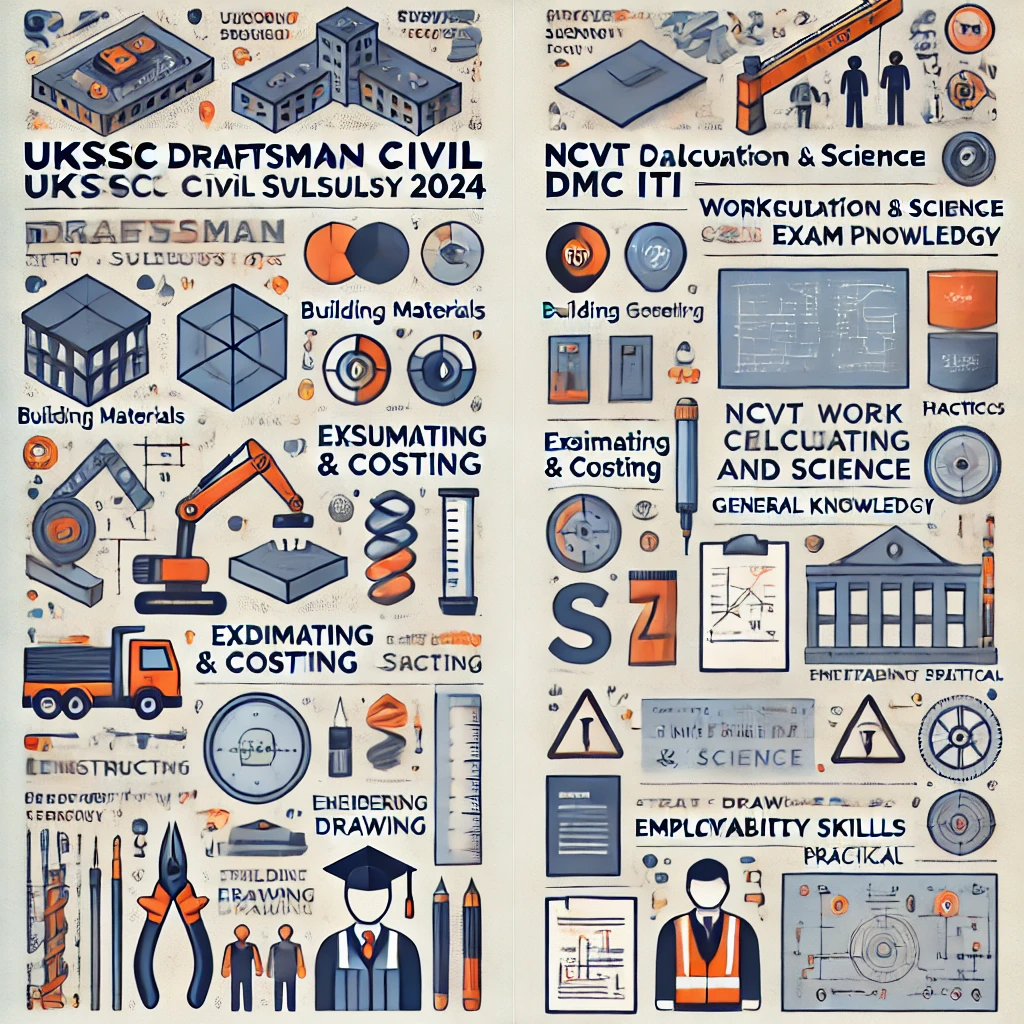The UKSSSC Draftsman Civil Exam 2024 is a key recruitment examination conducted by the Uttarakhand Subordinate Service Selection Commission (UKSSSC) for the post of Draftsman (Civil) in Uttarakhand Irrigation Department (Sichai Vibhag). The syllabus is based on latest ITI draftsman civil (DMC) syllabus, prescribed by NCVT (National Council for Vocational Education and Training).
This exam aims to assess candidates technical knowledge in civil engineering and their ability to handle the responsibilities of a civil draftsman. Check latest UK Civil Draftsman Syllabus 2024 below.

Contents
UKSSSC Draftsman Civil Syllabus 2024
The syllabus for the UKSSSC Draftsman Civil Exam primarily focuses on the core subjects of civil engineering. As per official notification there is no mention of general studies and Uttarakhand GK in the syllabus pattern of civil draftsman. Here’s a breakdown of the major topics:
1. Occupational Health and Safety
Importance of safety and general precautions observed in the in the industry, introduction to First aid, introduction to PPES, response to emergencies e.g., power failure, fire alarm, etc.
2. Engineering Drawing
Symbols & conventional representation for materials in sections as per IS 962- 1989, SP- 46:2003 for building drawings, lines, lettering and dimension in Construction of plain geometrical figures.
Knowledge of different types of scale, principle of R.F, three views in Orthographic Projection of line, plane, Solid objects & section of solids, Isometric Projection of geometrical solids, Construction of solid geometrical figures, Oblique and Perspective views of step block
3. Building materials
- Stones: Characteristics, types & uses.
- Bricks: Manufacturing,characteristics of good bricks, types, uses and hollow bricks.
- Lime: Characteristics, types, manufacturing & its uses
- Pozzolanic materials: Characteristics, types & uses.
- Cement: Manufacturing, characteristics, types, uses and tests of cement
- Sand: Characteristics, types & uses.
- Clay Products: Types, earthenware, stoneware, porcelain, terracotta, glazing.
- Mortar & Concrete: Types, uses, preparation, proportion, admixtures and applications Timber: Types, structure, disease & defects, characteristics, seasoning, preservation and utility.
- Alternative materials to timber- Plywood, block board, particle board, fire proof reinforced plastic (FRP), Medium density fireboard (MDF) etc.
- Tar, bitumen, asphalt: Properties, application and uses.
- Paints: Characteristic, types and uses.
- Varnishes: Characteristics and uses.
- Metal: Characteristic, types and uses. Plastics: Characteristic,types and uses.
4. Building Construction
- Sequence of construction of a building. Name of different parts of building.
- Stone masonry: Terms, use and classification, principle of construction, composite masonry, strength of walls, strength of masonry.
- Brick masonry-principles of construction of bonds, tools and equipments used. Foundation: Purpose of foundation, causes of failure of foundation, bearing capacity of soils, dead and live loads, examination of ground, types of foundation, drawing of foundation footing, setting out of building on ground, excavation, simple machine foundation, types of shoring and scaffolding in details, types of underpinning and timbering in detail
- Treatments of building structures: DPC, sources and effects of dampness, Methods of prevention of dampness in building
Damp proofing materials – properties, function and types. - Anti-termite treatment – objectives, uses and applications. Weathering course -objectives and materials required. Fire proofing- effect and rules.
- Arches-Technical terms, types, centring
- Lintel- types, wooden, brick,stone, steel & RCC.
- Chajjahs- Characteristics, centring & shuttering Doors -Parts, location, standard sizes, types. Windows-types.
- Ventilators- purpose, types
- Floors- Ground & upper floor-Types
- Flooring- materials used types
- Stairs: Terms, Requirements, Planning and designing of stair and details of construction. • Basic concept of lift and Escalator
- Roofs & Roof coverings: objectives, purposes, elements, types etc.
- Truss-king post, queen post, mansard, Belfast, steel, composite etc.
5. Building Principle of planning, objectives & importance, function & responsibility, orientation, local building Bye-Laws as per IS code, lay out plan & key plan, provisions for safety.
6. Building Planning- Economy & orientation, provision for lighting and ventilation, provision for drainage and sanitation, types of building, planning & designing of residential, public and commercial buildings.
7. House drainage of building- Introduction, terms used in PHE, systems of sanitation, system of house drainage, plumbing, sanitary fittings, etc., types of sewer appurtenances, systems of plumbing, manholes & septic tank, water treatment plant, sewage treatment plant
8. Surveying
- Introduction, history and principles of chain survey.
- Instrument employed, their use, care, maintenance and common terms, classification, accuracy, types.
- Main divisions (plane & geodetic).
- Chaining: field work and office work.
- Compass survey: Instrument, bearing, traverse, local attraction, magnetic declination and true bearing, precautions in using prismatic compass and surveyor compass.
- Plane table survey: Instrument used in plane table survey, care and maintenance of plane table
- Levelling: Auto level, dumpy Level, tilting level – introduction, definition, principle of levelling, levelling staffs and its types, components / parts and function of different levels, temporary and permanent adjustment, procedure in setting up, level & horizontal surface, datum, benchmarks, focusing & parallax, deduction of levels / Reduced Level, types of levelling, application of chain and levelling instruments in building construction.
- Contouring: Definition, characteristics, methods, direct and indirect methods, interpolation of contour, contour gradient, uses of contour plan and map.
- Theodolite survey: Introduction, types of theodolites, uses, methods of plotting, terms of transit theodolite, fundamental axes of theodolite, adjustment of theodolite, checks and adjustment of errors, open and closed traverse and their application to Engineering problems, vernier scale- types, measurement of horizontal angle, measurement of vertical angle, adjustment of a closed traverse, problems in transit theodolite, departure, latitude, northing and easting.
- Curves- types, designation of curves, setting out simple curve by successive bisection from long chords, simple curve by offsets from long chords
- Total Station:- Introduction, principle of EDM, rectangular and polar co-ordinate system, Terminology of open and closed traverse
- GPS: Introduction, definition and application of Remote sensing
9. Concepts of design of earthquake resistant buildings- requirements, resistance, safety, flexible building elements, special requirements, base isolation techniques
10. Reinforced cement concrete structure:- Introduction to RCC, uses, Materials proportions, form work, bar bending details as per IS Code, reinforced brick work, materials used for RCC Construction, selection of materials coarse aggregate, fine aggregate, cement, water and reinforcement, characteristics of materials, method of mixing concrete- machine mixing and hand mixing, slump test, structural elements columns, beams, slabs -one-way slab & two-way slab, grade of cement, steel- behaviour and test, retaining wall, R.C.C. Framed structure
11. Steel structures:- Common forms of steel sections, structural fastener, joints, tension & compression member, classification, fabrication, construction details
12. Roads: Introduction, history of highway development, general principles of alignment, classification and construction of different types of roads, component parts, road curves, gradient, road drainage system
13. Bridges & Culverts: Introduction to bridges, Component parts of a bridge, classification of culverts, IRC loading, selection of type and location, factors governing the ideal site, alignment of bridge, selection of foundation, caisson, coffer dam- types, types of super structure, substructure-piers, abutments, wing walls, classification of bridges, tunnels- rules used for the sizes of different members
14. Railways: Permanent way, types of rails, rail gauges, functions, requirements, types, sections, length of rail, welding of rail, wear of rail, coning of wheels, hogged rail, bending of rail, creep of rail, causes and prevention of creep, sleeper and ballast-function, types, requirement, materials, fixtures, fastenings and plate laying in rail, types of joints, fish plate, fish bolt-spikes, chairs and keys-bearing plate, block elastic, base plate, anchors and anti-creepers, construction of permanent ways, railway station and yards.
15. Irrigation Engineering: Terms used in irrigation and Hydrology like duty, delta, base period, intensity of irrigation, hydrography, peak flow, run off, catchment area, CCA, crops like rabi, kharif etc, diversion head works -characteristics and types, Reservoir -types of reservoirs, i.e., single purpose and multi-purpose, area, capacity and curves of reservoir, dams, weir & barrages- types and purposes, hydro electric project components like forebay, penstock, turbines, power house, etc., canals- classification and distribution system, types of cross drainage works like aqueduct, super passage, syphon, level crossing, inlet and outlet, etc
16. Estimating and Costing: Introduction, purpose and common techniques, drawings of construction, measurement techniques, estimate-necessity, importance and its types, rate analysis of typical items and their specifications, labour and materials, schedule of rates, estimating of irregular boundaries by trapezoidal and Simpson’s formula, bar-bending schedule
17. Carpentry joints: Terms, classification of joints, uses, types of fixtures, fastenings.
18. Computer Aided drafting: Operating system, hardware & software, introduction to CAD, its Graphical User Interface, basic commands of CAD, knowledge of Tool icons and set of Toolbars, knowledge of shortcut keyboard commands.
UKSSSC Draftsman Civil Exam Pattern 2024
The exam pattern for the UKSSSC Draftsman Civil Exam 2024 is designed to evaluate technical knowledge of the candidates. The pattern includes the following components:
- Type of Exam: Objective-type, multiple-choice questions.
- Exam Duration: 2 hours.
- Total Marks: 100 marks.
- No. of Questions: 100 Questions
- Technical Subject (ITI Civil Draftsman): 100 marks.
- Negative Marking:- A deduction of 1/4th mark for each incorrect answer. (0.25 Marks)
| Conducted By | Uttarakhand Subordinate Service Selection Commission (UKSSSC) |
| Name of Post | Draftsman Civil (Praroopkar) (Uttarakhand Irrigation Department) |
| No of Vacancies | 140 Posts |
| Category | Syllabus & Pattern |
| Post Code | 671/388/63/2024 |
| Salary | Salary Range is: ₹ 35,400 to ₹ 1,12,400 (Level-6) |
| Expected Exam Date | 25 November 2024 |
| Selection Process | Written Exam & DV |
| Exam Type | Offline OMR Based |
| Official Website | sssc.uk.gov.in |
Important Links Related To Civil Draftsman Syllabus
- Must See: UKSSSC Draftsman (Civil) Recruitment 2024 Notification & Vacancy Details
- Must See: UKSSSC ITI Technician Electrical/Mechanical (UJVN) Recruitment 2024 & Vacancy Details
- Also See: UKSSSC Nalkoop Mistri (Tubewell Mechanic) Syllabus & Pattern 2024
- For UKSSSC ITI Recruitment Notification/Advertisement: Click Here
- Uttarakhand Latest Government Jobs:- https://4syllabus.in/tag/uttarakhand/
- UKPSC Latest Updates & Notifications:- https://4syllabus.in/tag/ukpsc/
- UKSSSC Latest Updates & Notifications:- https://4syllabus.in/tag/uksssc/
- For Official UKSSSC Website: http://sssc.uk.gov.in
UKSSSC Draftsman Civil Exam 2024
The UKSSSC Draftsman Civil Exam 2024 provides an opportunity for the candidates to get a good govt job in Uttarakhand State Govt. In case of any doubt or question related to this recruitment, please drop your queries in the comment section. Till then, best of luck.
Important FAQs
What is the exam pattern for UKSSSC Draftsman Civil 2024?
- The exam consists of 100 objective-type questions with a duration of 2 hours.
- Technical subjects (Civil Draftsman) carry 100 marks. No mention of Uttarakhand GK in notification.
- There is negative marking of 1/4th mark for every wrong answer.
What is the difficulty level of the exam?
The difficulty level will be based on ITI draftsman syllabus prescribed by NCVT.
Is there a separate section for engineering drawing in the exam?
While there is no specific section, engineering drawing forms part of the ITI civil syllabus. Candidates are expected to know the basics of technical drawings and blueprint interpretation.




![UKSSSC Kanishth Sahayak (Mate) Recruitment 2024 Vacancy Details [751 Posts]](https://4syllabus.in/wp-content/uploads/2024/10/UKSSSC-Kanishth-Sahayak-Mate-Recruitment-2024-Vacancy-Details-751-Posts-150x150.webp)

